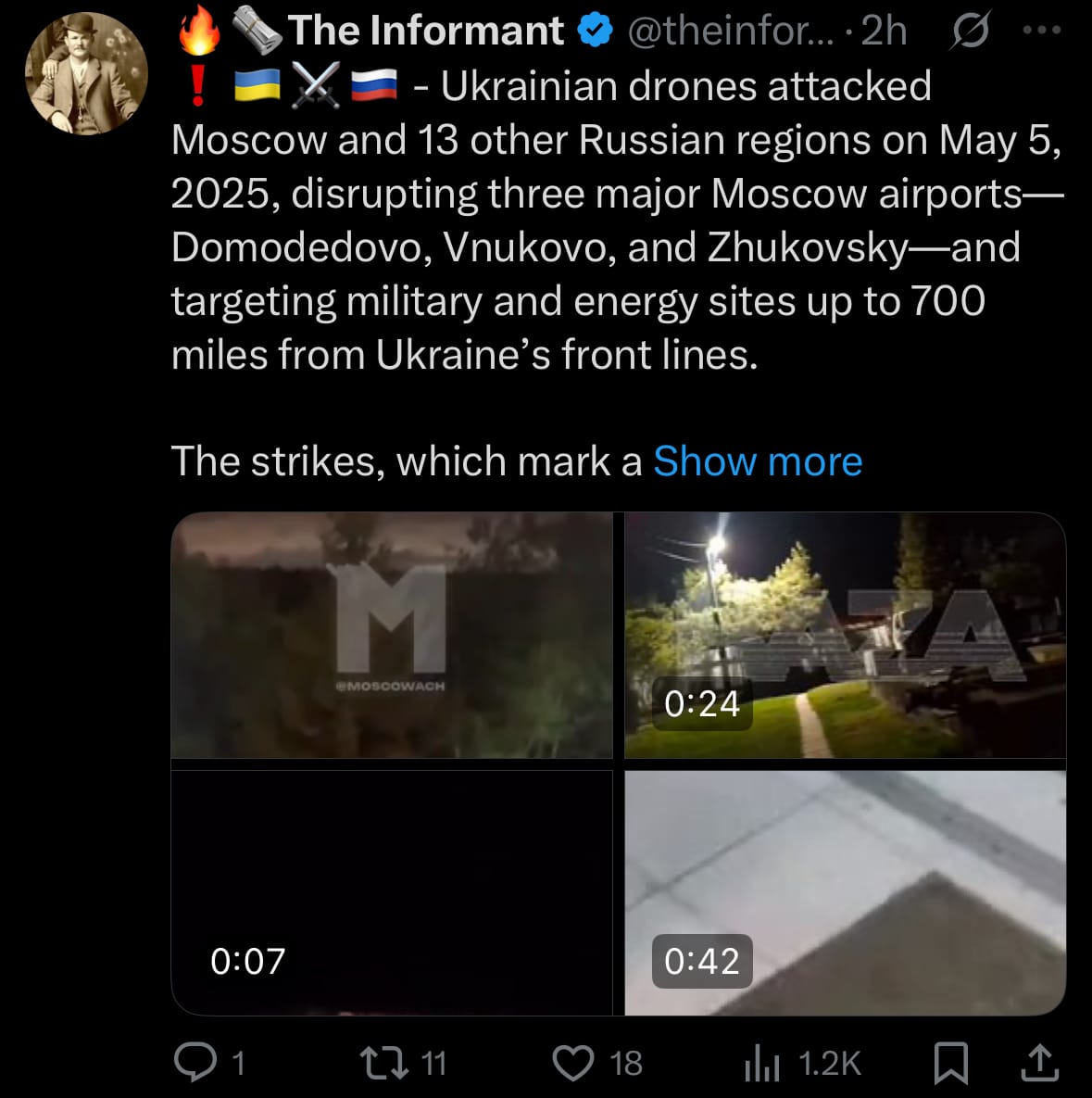Tuesday☕️

Trending:
- Yesterday, May 5, 2025, President Donald J. Trump signed an Executive Order halting all federal funding for gain-of-function research in high-risk countries with inadequate biosafety regulations. Gain-of-function research involves deliberately modifying pathogens, such as viruses like SARS or avian influenza, to make them more transmissible or deadly, typically to study potential pandemic risks and develop countermeasures. The order stops U.S. support for such research abroad due to risks of laboratory accidents or misuse and pauses it domestically until the Office of Science and Technology Policy revises safety guidelines within 120 days for stricter oversight and transparency.

- The order also restricts funding for other life-science research in nations lacking robust oversight and introduces regulations for privately funded gain-of-function studies. It updates nucleic acid synthesis screening to prevent hazardous experiments and mandates regular policy reviews. These measures aim to balance advancements in biotechnology with enhanced public safety and national security, addressing concerns about the potential dangers of manipulating pathogens.
Economics & Markets:
- Yesterday’s U.S. stock market:

- Yesterday’s commodity market:

- Yesterday’s crypto market:

Geopolitics & Markets:
- Yesterday, May 5, 2025, Ukraine conducted a large-scale drone attack targeting Moscow and 13 other Russian regions, disrupting operations at three major Moscow airports—Domodedovo, Vnukovo, and Zhukovsky—where flights were delayed or diverted. The drones struck military bases and energy facilities, some as far as 700 miles from Ukraine’s front lines, showcasing Kyiv’s advanced long-range capabilities. Russian authorities reported intercepting several drones and activating air defenses in Moscow, but information on damage or casualties remains scarce.

- Yesterday, May 5, 2025, Israel launched airstrikes on Hodeidah, a Houthi-controlled port city in Yemen, targeting the port, Hodeidah International Airport, and nearby sites, including a cement factory, in response to a Houthi missile attack near Tel Aviv’s Ben Gurion Airport the previous day. Around 30 Israeli warplanes conducted 12 strikes, using 50 precision-guided munitions to hit Houthi military targets, with U.S.-Israeli coordination confirmed. U.S. warplanes also struck Houthi positions in Sanaa, Marib, and Al-Jawf. Houthi officials reported two deaths and 42 injuries, stating the attacks disrupted a key hub for food and fuel imports.

Environment & Weather:
- Yesterday, May 5, 2025, heavy rainfall triggered widespread flooding in Batam, Indonesia, a city in the Riau Islands, submerging streets, homes, and businesses. Social media posts on X showed residents wading through knee-deep water in areas like Batam Center’s Marbella complex, with traffic paralyzed on major roads. Local sources attribute the flooding, the third major event this year in some areas, to poor drainage systems clogged with sediment and debris. Emergency services are responding, but no official reports on casualties or damages have been released. The floods have heightened local concerns about the city’s infrastructure and its ability to handle extreme weather.

- Batam has faced repeated flooding this year, including a January event that caused a landslide, killing four and displacing many. Despite calls for better drainage and urban planning, Batam lacks a dedicated disaster management agency, and infrastructure upgrades remain limited. With perigee tides expected soon, potentially worsening coastal flooding, authorities face increasing pressure to address these recurring challenges and improve resilience against future disasters.

Science & Technology:
- Yesterday, May 5, 2025, Anduril Industries unveiled Menace-T, a portable command and control system, and announced it acquired Klas, a company that builds rugged, compact computers. Menace-T is a lightweight system packed into two small cases that one person can carry and set up in five minutes. It acts like a high-tech hub, letting soldiers in remote or dangerous areas connect devices, process live data from sensors (like cameras or drones), identify targets, and plan missions instantly. Using Anduril’s Lattice software and Klas’ technology, it works even when communication signals are weak or jammed, and it supports tools like virtual reality headsets for U.S. soldiers. It’s already used in military vehicles and ships worldwide.

- Unlike older, bulky systems that take days and multiple people to operate, Menace-T is simple, fast, and reliable. It connects easily with other Anduril products and outside software, making it adaptable for various tasks. With Klas’ expertise, Anduril plans to make even tougher, faster technology that could one day help police or self-driving systems. This launch and acquisition highlight Anduril’s focus on creating practical, advanced tools to keep soldiers connected and effective in tough environments.
Statistic:
- Largest public semiconductor companies by market capitalization:
- 🇺🇸 NVIDIA: $2.777T
- 🇺🇸 Broadcom: $943.77B
- 🇹🇼 TSMC: $914.90B
- 🇳🇱 ASML: $270.44B
- 🇰🇷 Samsung: $260.96B
- 🇺🇸 AMD: $163.42B
- 🇺🇸 QUALCOMM: $153.10B
- 🇺🇸 Texas Instruments: $147.55B
- 🇬🇧 Arm Holdings: $128.53B
- 🇺🇸 Applied Materials: $125.61B
- 🇺🇸 Analog Devices: $98.06B
- 🇺🇸 Lam Research: $94.53B
- 🇰🇷 SK Hynix: $93.49B
- 🇺🇸 KLA: $91.68B
- 🇺🇸 Micron Technology: $89.87B
- 🇺🇸 Intel: $88.41B
- 🇺🇸 Synopsys: $73.81B
- 🇹🇼 MediaTek: $70.79B
- 🇯🇵 Tokyo Electron: $67.39B
- 🇨🇳 SMIC: $60.78B
- 🇺🇸 Marvell Technology: $53.67B
- 🇳🇱 NXP Semiconductors: $46.72B
- 🇩🇪 Infineon: $44.31B
- 🇯🇵 Advantest: $32.35B
- 🇺🇸 Monolithic Power Systems: $30.03B
History:
- The history of military technology began in prehistoric times, with early humans crafting rudimentary weapons like sharpened stones, wooden spears, and clubs for hunting and tribal conflicts around 30,000 BC. The bow and arrow, emerging around 20,000 BC in Africa and Europe, marked a pivotal leap. Initially a hunting tool, its ability to strike from a distance with accuracy and lethality transformed warfare. Early bows were simple, made from flexible wood, but by 4000 BC, Central Asian nomads developed composite bows—combining wood, horn, and sinew—for greater power and range, enabling mounted archers like the Scythians to dominate with hit-and-run tactics. Around 3500 BC, the invention of the wheel in Mesopotamia introduced chariots, which, paired with archers, created fast, deadly units in Egyptian and Hittite armies. By 3000 BC, metallurgy in Mesopotamia and Egypt produced bronze swords, axes, and armor, offering superior durability over stone weapons. Ironworking, spreading by 1000 BC, made weapons cheaper and more widespread. Siege technologies, like battering rams and early catapults, appeared by 500 BC, while in China, the crossbow, refined by the 5th century BC, provided unmatched power, though slower to reload than traditional bows. Archers, especially in massed formations, remained central to ancient armies, as seen in Egyptian reliefs and Persian tactics.
- As civilizations advanced, military technology grew more sophisticated, with the bow and arrow retaining a central role. By the 1st century BC, the Parthians’ horse archers, wielding composite bows, crushed Roman legions at Carrhae (53 BC), showcasing archery’s battlefield supremacy. The Huns and later Mongols, from the 4th to 13th centuries AD, used similar tactics to build vast empires. In medieval Europe, the English longbow, developed around 1000 AD, became iconic for its range and armor-piercing power, famously decisive at Agincourt (1415). However, gunpowder, invented in China by the 9th century and spreading to Europe by the 13th century, began to shift warfare. Early cannons and firearms, though crude, evolved into reliable muskets and artillery by the 16th century, gradually phasing out bows. The Industrial Revolution in the 19th century introduced mass-produced rifles, machine guns, and ironclad warships, while the 20th century saw tanks, aircraft, and nuclear weapons revolutionize combat. Modern militaries now rely on drones, precision missiles, and AI-driven systems. The bow and arrow, dominant for millennia due to its versatility and range, laid a foundation for the relentless innovation in military technology, shaping warfare’s evolution from primitive skirmishes to global conflicts.
Image of the day:

Thanks for reading!
Earth is complicated, we make it simple.
Click image to view the Earth Intelligence System:



Support/Suggestions Email:
earthintelligence@earthintel.news




